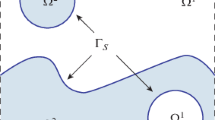Abstract
A system of two approaching fluid particles at small gap widths is investigated. The concept of “an effective zone of interaction” is used to analyse the stationary Navier-Stokes equations in the respective phases. Particular cases are distinguished in which it is possible to make significant simplifications in the governing differential equations. A validity criterion for the lubrication theory equations in the thin layer is proposed, which accounts for the tangential mobility of the interfaces.
Similar content being viewed by others
References
Beshkov V, Radoev B, Ivanov I (1968/69) Ann Univ Sofia 63:197
Riolo E, Reed XB, Hartland S (1975) J Coll Interf Sci 50:49
Ivanov I, Traykov T (1976) Int J Multiphase Flow 2:397
Zapryanov Z, Malhotra AK, Aderangi N, Wasan DT (1983) Int J Multiphase Flow 9:105
Mileva E, Radoev B (1985) Coll & Polym Sci 263:587
Happel J, Brenner H (1976) Low Reynolds number hydrodynamics, Mir, Moscow, in Russian, p 43
Cox R, Brenner H (1967) Chem Eng Sci 22:1753
Author information
Authors and Affiliations
Rights and permissions
About this article
Cite this article
Mileva, E., Radoev, B. Effective zones of hydrodynamical interaction of fluid particles at small separations. Colloid & Polymer Sci 264, 823–828 (1986). https://doi.org/10.1007/BF01500761
Received:
Accepted:
Issue Date:
DOI: https://doi.org/10.1007/BF01500761




